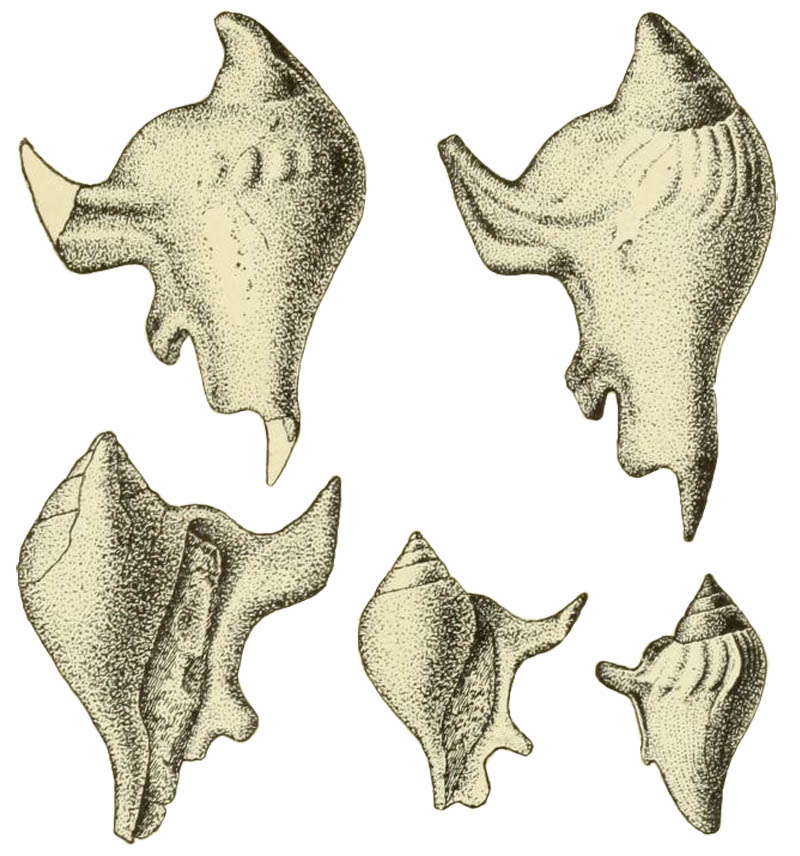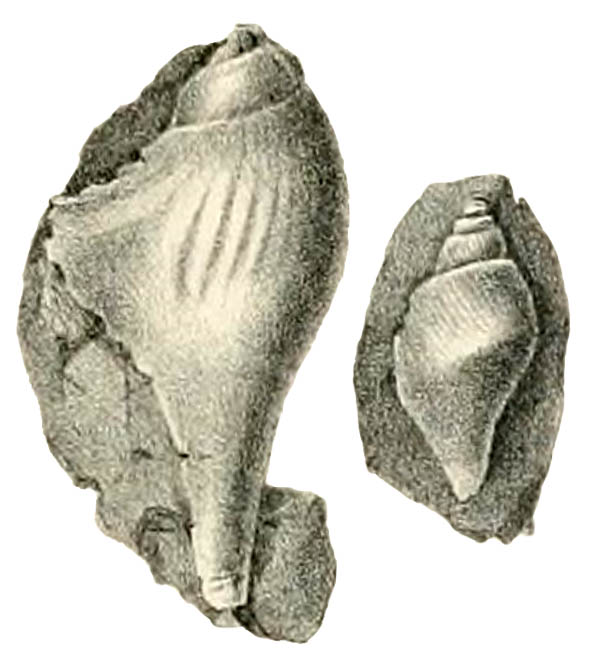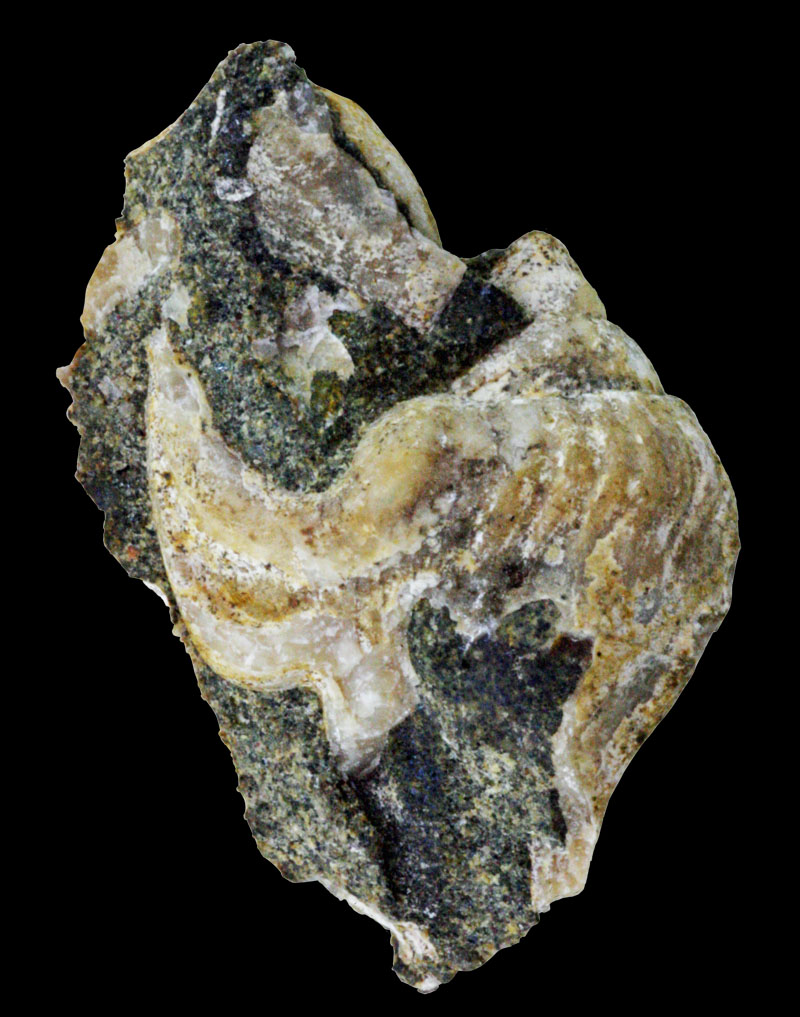|
edit SideBar
|
Species / Gymnarus Fusiformis
Stromboidea
Original Description of Anchura? fusiformis by Meek, 1877, p. 160:
- "Shell subfusiform; spire conical, rather short; volutions about five, moderately convex, those of the spire smooth and separated by a comparatively distinct suture; last one subovate, obscurely angular around the middle in young examples, but with angle entirely obsolete in the adult, gradually tapering below into a long, straight, rather stout canal, which has some appearance of being obliqueliy truncated at the extremity; outer lip, with extension apparently short, simple, and slightly recurved; surface with only obscure lines of growth, escepting near the lip on the body-volution in adult shells, where there are usually a few small, slightly oblique, longitudinal costae, that become obsolete before reaching the suture above and a little below the middle of the volution. (Aperture and columella unknown.)
Anchura? fusiformis Meek, 1877, pl. 15, figs. 2, 2a
History and Synonymy
1894
Description of Pugnellus fusiformis by Stanton, 1893, p. 148:
- "Shell, exclusive of the outer lip, fusiform, consisting of six or seven volutions, of which the last forms about five-sixths of the total length; the whorls of the spire are sometimes subangular above the middle, and the body-whorl is ventricose in the same region ; suture distinct in young shells, but almost entirely covered in the adult by a very heavy spiral callus, which extends backward from the inner lip over the apex of the spire; aperture narrow, oblong; outer lip in the adult greatly thickened and expanded, bordered externally by a heavy ridge. The posterior expansion of the outer lip is broad falciform, slightly narrowed at the base, somewhat twisted so that it is not quite in the same plane as the rest of the margin, directed backward and outward, and terminating in a blunt point. About midway between this falciform process and the anterior end of the canal there is a smaller subquadrate projection, directed downward and forward, in front of which there is a deep, narrow sinus, followed by a third projecting lobe that is broadly rounded and separated from the anterior end of the canal by a well-defined notch. The tip of the canal is slightly bent inward. The shell is very thin on the dorsum, which is the only portion not covered in the adult by a heavy callus. Surface smooth, excepting on the upper portion of the body-whorl, where it is marked by more or less prominent curved transverse costae that are sometimes shortened into nodes. From the front end of the last costa a rather prominent subangular ridge, corresponding to the angulation of the earlier whorls, passes out on the outer lip and forms the upper (posterior) border of the falciform process. In the earlier stages of its growth the shell has a much more simple form.
- Length of a large specimen, 41 mm ; breadth, including the expanded outer lip, 39 mm; diameter of body- whorl, exclusive of lip, 16 mm .
- This description is drawn from a large collection of well preserved specimens from Huerfano park, Colorado. At several localities the species is very abundant in a bed of sandstone, which I have, for that reason, called the Pugnellus sandstone, as a convenient local designation. The original types of Meek's species are imperfect sandstone casts from the neighborhood of Coalville, Utah, while White's types, also imperfect and showing different features, came from the Arkansas river above Pueblo, Colorado. Better collections recently made at both these localities prove that they all belong to the species that is so abundant in Huerfano park, and that it has all the characteristic features of Pugnellus. The most nearly related form is Pugnellus manubriatus Gabb, from the Chico series of California, but the resemblance is not so close as to require minute comparisons.
- Locality and position. — At the localities mentioned in Colorado the species is confined to the upper part of the Fort Benton, being most abundant in the thin bed of Pugnellus sandstone, just beneath the Niobrara limestone, and very rare in the ux>per part of the underlying shales. At Coalville, Utah, it occurs in the sandstone of the "second ridge," where it is associated with many of the same species that are found with it in Colorado. It has also been found at the same horizon at Bear River city, Wyoming."
 Pugnellus fusiformis in Stanton, 1894, pl. XXXI, fig. 7-11
Specimens from private collections
Gymnarus cf. fusiformis; Upper Cretaceous; Redding, Shasta County, California, USA; Coll. Ulrich Wieneke
References
- J.I.Kirkland, 1996. Paleontology of the Greenhorn cyclotherm (Cretaceous: late Cenomanian to middle Turonian) at Black Mesa, northeastern Arizona; Bulletin of the New Mexico Museum of Natural History and Science 9, pp. 1-131, pl. 1-50, Fulltext, Fulltext
- F. B. Meek. 1877. Part I. Palaeontology. Report of the Geological Exploration of the Fortieth Parallel 4:1-197 Fulltext
- Stanton, T.W. 1893 [1894]. The Colorado formation and its invertebrate fauna; U.S. Geol. Survey Bull. 106, 288 p., 45 pls., fulltext
|



